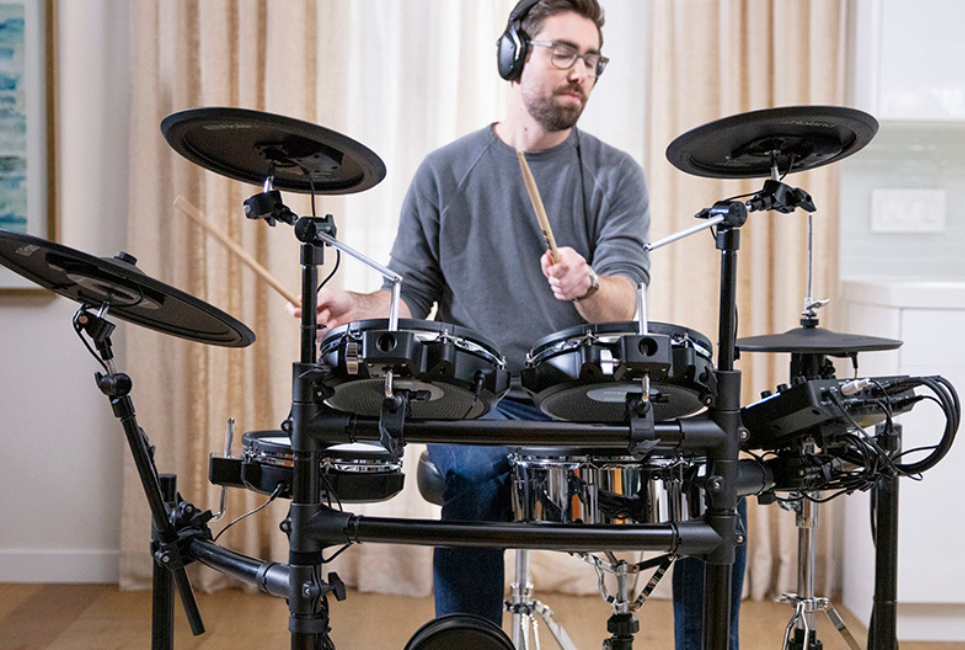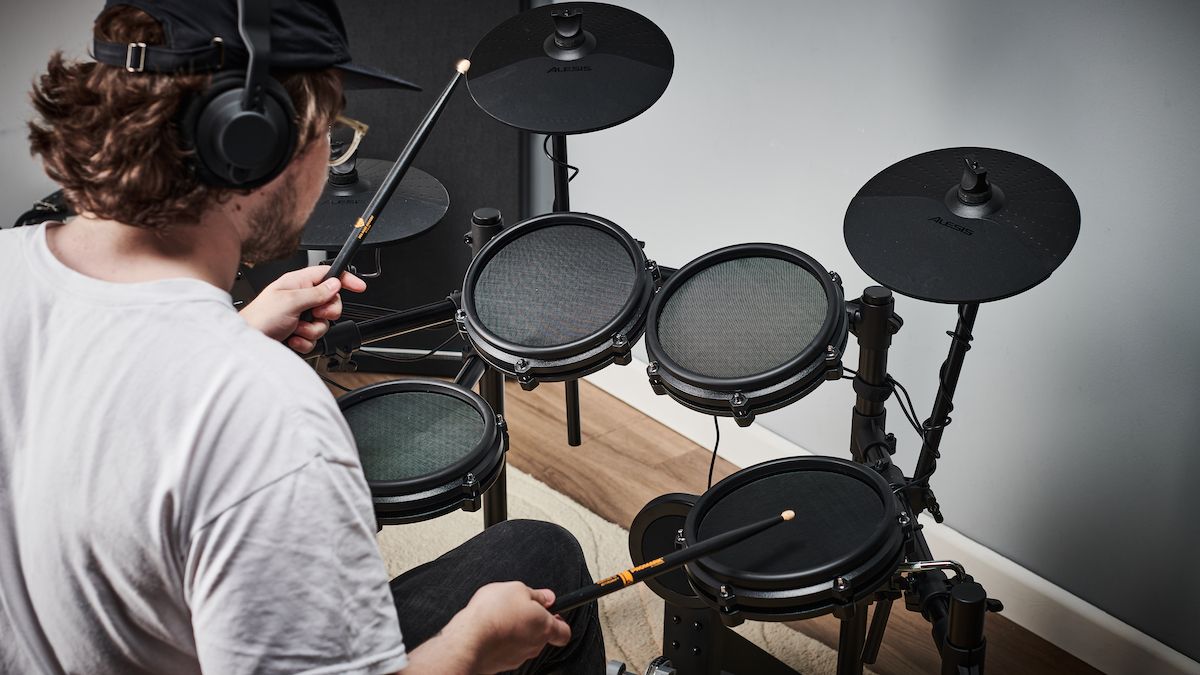- Lights, Camera, and Action: How to Film and Edit a Drum Cover - May 31, 2022
- The Best Wuhan Cymbals: A Comprehensive Buying Guide - May 30, 2022
- Alesis Surge vs Command Compared - April 26, 2022
Alesis has rightfully earned the title of being today’s leading music tech giant, and they’ve done this by creating instruments that are both high quality and affordable. Ever since their first release in 1984 (the XT Reverb), Alesis has contributed some of the most versatile and capable musical instruments to the community.
Alesis understandably captures the attention of the average drummer, as they make affordable and good-sounding kits – if not better than well-known brands like Roland and Yamaha.
Not only do their latest additions mark a significant improvement in terms of sound and feel over previous releases, but they have also added more accessibility features to the recording and songwriting elements of the kit.
The California NAMM Show (hosted by the National Association of Music Merchants), held in 2020, saw Alesis release two new e-drum kits:
- The Alesis Command
- The Alesis Surge
These two were long-awaited by the fans of both the Nitro Mesh kit and the DM-series kits. Unless your mind is already set, let’s stroll through a detailed review and comparison between the two drum kits to figure out which one suits you better.
My Bottom Line Up Front: While both the Alesis Surge and the Alesis Command can be tagged as affordable drum kits with a fairly powerful sound module, the Command is miles ahead of the Surge in terms of both performance and onboard sounds.
Although both kits sound pretty great right out of the box, there is a stark difference when it comes to their build quality. And as you probably might have guessed, the Command is leading here, too.
With that out of the way, if you are looking for some close alternatives, you can never go wrong with these e-drum kits:
- Roland TD-1DMK (Best value for your money!)
- Yamaha DTX-452K (A studio-ready e-drum kit.)
Main Differences Between the Alesis Surge vs Alesis Command

There are a few notable differences between these two e-drum kits, including:
- The number of sounds available on both of the modules. The Alesis Command clearly comes on top here with its staggering total of 671 onboard sounds, whereas the Surge only has 385.
- The amount of drum presets on each. The Alesis Command offers users 54 factory drum presets, whereas the Alesis Surge maxes out at 40 presets.
- The ability to upload custom samples. The Alesis Command lets you upload custom samples to your e-drum kit via USB thumb drive, whereas the Surge does not offer such a feature.
- The option of included pre-loaded songs. Alesis Command comes with 120 built-in songs for practicing or jamming, whereas the Surge comes with 60.
What To Look For In an Electronic Drum Kit
When it comes to e-drum kits, your buying decision can sway in multiple directions. Of course, this can vary, depending on the utilities you expect to get out of your kit.
To make it easy for beginners and intermediate players alike, I’ve segregated a few buying tips that can be of great help to your future purchase:
- Determine how many pads you need.
- Choose the right drum module.
- Consider the build quality.
- Determine your input and output options.
Determine the Number of Pads
First things first: you must decide on how many pads are actually relevant to your project or play style. Both the Alesis Surge and the Alesis Command come with the standard number of:
- Kick
- Snare
- Tom
- Hi-hats
However, if you think you might need to expand your kit in the future, consider buying an e-drum kit that allows you to plug-in additional trigger inputs.
Pick Out Your Drum Module
This is the central processing unit of your electronic drum kit, so you’ll want to make sure you pick one that is powerful enough to power your musical endeavors. Depending on the price, both the performance and in-built features of sound modules will vary drastically.
If you are a beginner, a bottom-of-the-line drum module will likely be an excellent choice for you. It’ll house enough presets and onboard sounds to get you familiar with the world of electronic drums.
On the other hand, if you are looking to employ your kit in a professional scenario, you might want to go with a high-end drum module. A higher-end module can offer the best sound engine and lowest perceivable latency, making it more than worth the investment.
Focus On Build Quality
This is an important one for players who tend to play with a heavy hand or gig a lot. There is no doubt that high-end drum kits will have more robust features and build quality, but if you are looking to get a sturdy kit for a lower price, there are some great options in the mid-range category of e-drums.
Choose the Input and Output Options
Beginners and intermediate drummers might not have to worry about additional input or output sources. However, if you were ever going to get into recording your own music, this aspect should not be overlooked.
Depending on your project and recording setup, you may run into issues like not having enough output options for your mixer or lack of trigger inputs with your e-drum kit. It’s not a bad idea to sort out a general idea of recording or songwriting setup before investing in any MIDI-powered instrument.
Important Things to Keep in Mind!
- I highly recommend that you try out an electronic drum in a store or borrow one from a friend before purchasing one for yourself. There is no telling if you will prefer the sound and feel of electronic drums over acoustic drums if you have never laid a hand on the former.
- Since we are dealing with digital to analog signal conversion in e-drum kits, there will always be a perceivable latency in the sound coming out. High-end sound modules can squeeze this number down to a few milliseconds, but if you are looking at a mid-range kit, the latency factor needs to be incorporated into the decision-making process.
- Electronic drum kits basically replicate the sound of real drum kits on a virtual platform. Since you are actually playing the digital samples of other drum kits, they may not sound or feel as natural as the real deal. Keep this in mind if you are transitioning from an acoustic drum kit to an electronic one.
- If you think you might need to add additional components to your e-kit in order to expand the range of sounds, consider getting a kit with extra triggers and analog inputs. This way you can add multiple toms, cymbals, and pedals to your signal chain.
Alesis Surge Mesh Drum Kit
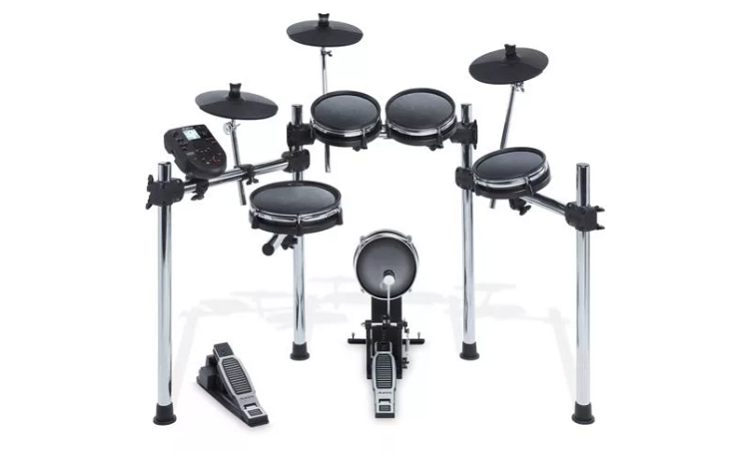
If you are coming from the acoustic drumming world, then you might not have heard the name before. Nonetheless, Alesis has been making news in the electronic music world for over two decades now.
The Surge Mesh kit improvises on the older generation kits, and it feels like a complete setup with its eight-piece configuration. The Alesis Surge boasts 10” dual-zone mesh drum pads that provide a realistic attack and feel when hitting the pads.
It’s the perfect choice if you were looking for a kit to grow into, and something that will not go out of fashion for a considerable time. Finally, this drum kit serves a hefty amount of I/O options for garage musicians, as well as a powerful sound engine to shape your tones in the mix perfectly.
Features
- Five 10” dual-zone mesh drum pads with chrome racks
- 3 cymbals pads, 8” kick pedal, and hi-hat pedal
- Sound module with 385 sounds and 24 drum presets (plus 16 custom kits)
- On-board recorder
- 60 in-built play-along tracks
- ⅛” aux input and input
Pros
- Feature loaded
- Rugged build and tensile design
- Double-bass programmable
Cons
- Rack adjustability is complex
- Mesh pads feel good but lack dynamics
Alesis Command Mesh Drum Kit
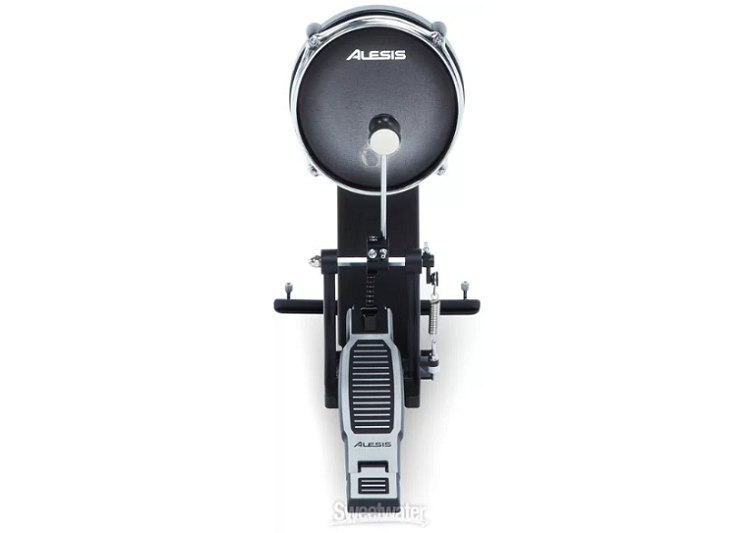
The Alesis command has a major upper hand over the Surge, mainly due to the fact that it holds more sounds, features, and presets in its bank. When it comes to the dimensions and feel of the pad, the differences between them are almost negligible.
All things considered, the Command sounds just as good and dynamic as the Surge. However, there is a word going around that the kick pedal on the Command feels more robust and accurate.
Furthermore, the Command features a couple of extra features handy for recording musicians. Both the kits feature a premium four-post chrome rack, so their durability and strength are more or less the same.
Features
- Five 10” dual-zone mesh drum pads with premium chrome racks
- 3 cymbals pads, 8” kick pedal, and hi-hat pedal
- Drum module (which holds 629 sounds, 50 drum kits, and 20 custom kits)
- WAV and MP3 sample import capability
- 70 built-in play-along tracks
- Internal recorder can capture up to 5 songs, or up to 99 via USB
- 1 x 1/8″ (aux in), 2 x 1/4″ TRS (main out)
Pros
- Great value for the money
- Song recorder can hold up to 99 songs
- Tons of variations for studio drummers
Cons
- Slight hardware quibbles, nothing major
- Rack adjustable takes a learning curve to master
The Two Alternatives That I’d Recommend
The options for drummers on the market are growing by the day as companies continue to flood the market with brand new ideas and technologies. Brands like Roland and Yamaha have been pushing the ceiling on electronic drumming kits for a while now, and they’ve developed quite a robust collection of kits in their catalog.
With that said, there are two alternatives to the Alesis Surge and the Alesis Command that I’d recommend, and those are the:
- Roland TD-1DMK
- Yamaha DTX-452K
Roland TD-1DMK
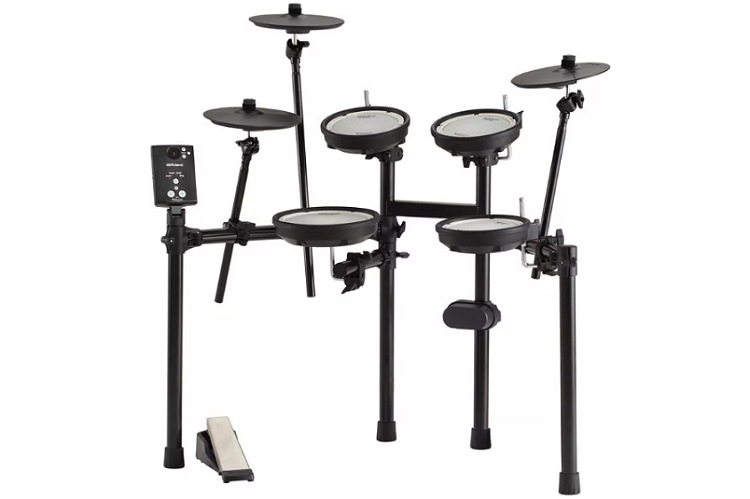
Roland was among one of the first manufacturers to break through the barriers and design kits that were not only eye-catching, but they also sounded great, too. Over the years, they have refined their technology to provide a fulfilling drumming experience to all kinds of drummers.
The Roland TD-1DMK provides a staggering collection of drum sounds on top of an intuitive interface that lets you shape and mold your tones to perfection. Roland’s V-drums technology provides a realistic drumming experience but without the noise — solid for those late-night practice sessions.
Yamaha DTX-452K
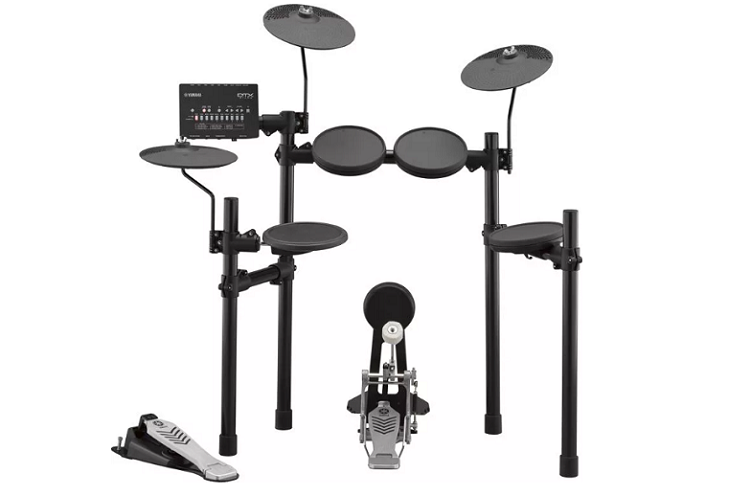
Yamaha raised the bar for electronic drum manufacturers when they came out with the DTX series. The TP70S 3-zone drum pads take drumming to a whole new level, as it allows you to make movements that were not possible with a traditional e-kit before.
It also features a versatile sound module and a robust kick pedal, which takes care of drummers that have always had issues with sticky kick pedals.
This drum kit also comes with an expressive hi-hat pedal and controller for extra dynamics. If you are looking for a studio-ready sound and money is not a limitation, this one should definitely be your pick.
Best Use Tips
- Make sure that your drum pads and other MIDI sources are properly mapped out in the drumming software. That way, you can avoid triggering incorrect pads or losing sound altogether.
- Setting up and mixing hi-hats sounds properly is the key to getting a realistic sound from e-drum kits.
- Run a click-track at all times if you are a beginner. This will not only tame your sense of timing, but it’ll also help you pick up new skills faster in the long run, too.
- Don’t discredit factory sounds and presets before trying them out. Sometimes you do find gold in some of those in-built kits, so don’t forget to give them a try.
- Drumming can be a lot more tactile if you tune the drum pads properly.
Frequently Asked Questions
Answer: Yes, both Alesis Surge and Command come with MIDI over USB capability, which allows you to connect to a DAW (digital audio workstation) of your choice via the computer.
Answer: Alesis Command comes with extra trigger inputs which allow you to connect additional drum pads or cymbals, whereas the Alesis Surge is missing such inputs. The option of expanding the drum kit is only available with the Alesis Command.
Answer: A drum amplifier would be your best bet. However, if you’re looking for a closer alternative, keyboard amps are your safest choice. Anything other than that is not safe to be used for amplifying drum sounds.
Answer: Yes, both Alesis Surge and Command provide in-built performance recorders. That said, the ability to expand storage is only available with the Command.
Final Thoughts
Electronic drum kits are a no-brainer when it comes to certain styles of music, but surprisingly enough, their usage across other genres has started going up in recent years. The current generation of electronic drum kits offers a near-realistic drumming experience and a massive onboard collection of sounds.
Alesis drum kits can help you power through your salad days of drumming, as well as build a deep insight into drumming techniques and music theory.
That said, if you are looking for a kit that suits your playstyle and offers plenty of room for you to grow in, then without a shred of doubt, the Alesis Command is your best pick.
Continue reading:

